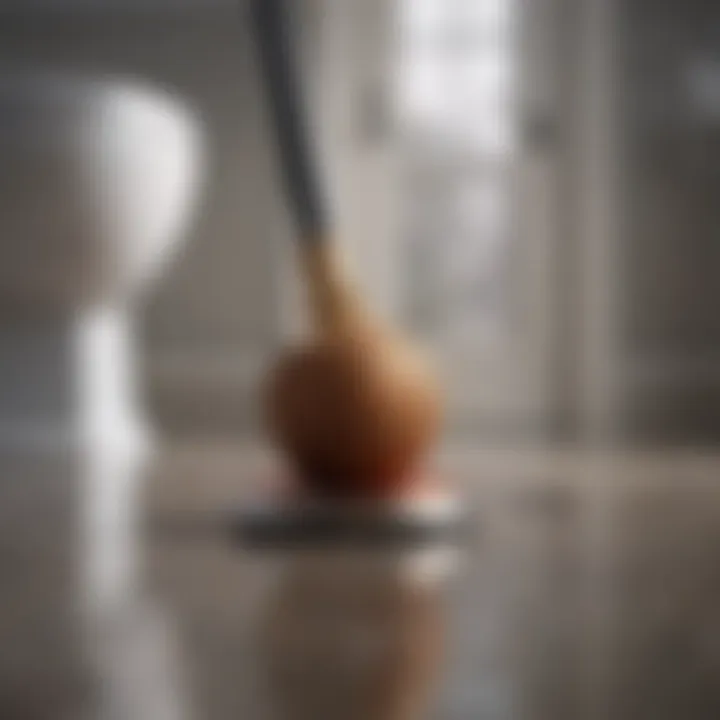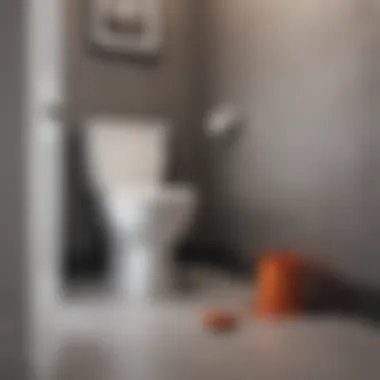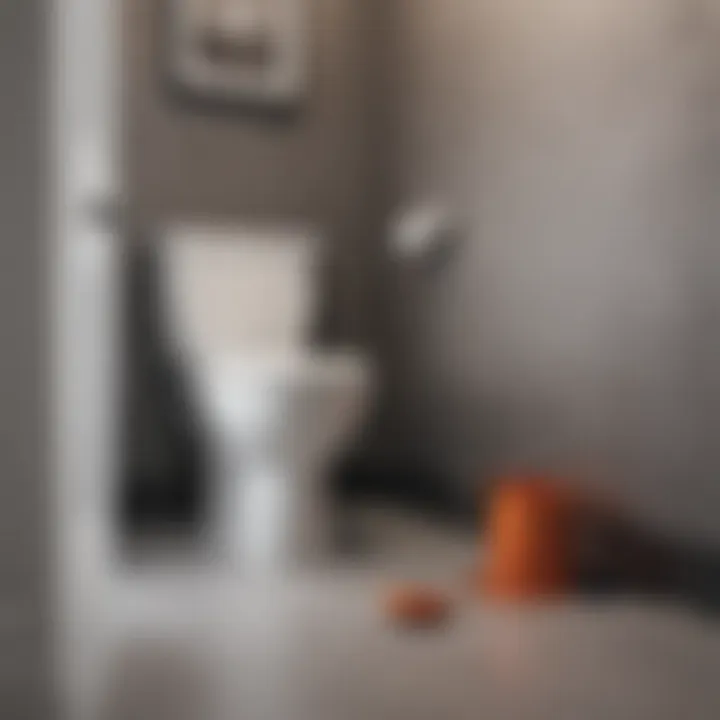Mastering the Art of Unblocking Toilets with a Plunger


Intro
Unblocking a toilet is an everyday household issue that many of us encounter at some point. Knowing how to effectively utilize a plunger can save time, frustration, and potentially costly repairs. This article aims to provide significant insights into the process of using a plunger, along with tools, techniques, and preventive measures. With the right knowledge, one can become confident in handling this home maintenance task.
Feature Spotlight
Understanding Plungers
Plungers come in various designs, with the two primary types being the cup plunger and the flange plunger. The cup plunger is more common for sinks and flat surfaces, while the flange plunger is specially designed for toilets. Having the right type is crucial for effective blockage removal.
- Cup Plunger: Best suited for sinks.
- Flange Plunger: Specifically engineered for toilets, enhancing suction.
Investing in a quality flange plunger can make your task of unblocking a toilet much easier.
"Using the correct plunger type ensures a more effective resolution to your plumbing issues."
Essential Tools and Materials
In addition to the plunger, it is essential to have several other materials on hand before tackling a blockage:
- Rubber gloves: For hygiene.
- Bucket: To catch overflow if necessary.
- Towels: For cleanup after the process.
- Drain cleaner: A secondary option if plunging fails.
Having these items ready can streamline the unblocking process and lessen any discomfort.
Step-by-Step Procedure
- Preparation: Start by putting on rubber gloves. Place a bucket near the base of the toilet to catch any overflow.
- Assess the blockage: If the water level is high, wait a moment to see if it lowers.
- Position the plunger: Ensure the flange plunger fits snugly into the toilet's drain hole.
- Plunge: Push down firmly and pull up with consistent rhythm. Repeat this several times.
- Check the results: After a few plunges, test if the water drains. Repeat if necessary.
These steps, although simple, require persistence and proper technique for successful blockage resolution.
Preventative Measures
To reduce the likelihood of future toilet blockages, consider implementing some preventative tips:
- Avoid flushing non-degradable items like wipes and feminine products.
- Regularly check toilet functionality for any warning signs of blockage.
- Consider periodic maintenance with appropriate cleaning products to break down debris.
Being proactive can help maintain your toilet’s functionality and prevent emergencies.
Troubleshooting Common Issues
Sometimes, even the best plunging efforts may not work. Here are common challenges and their solutions:
- Persistent blockage: If the toilet remains blocked after several plunges, try using a drain cleaner as a follow-up.
- Toilet bowl overflows: If the water rises too high, stop plunging immediately. Use the bucket to manage excess water.
- Determine severity: If nothing works, consider contacting a professional plumber to assess the situation.
Each of these potential problems can be addressed with careful consideration and the right approach.
End
Understanding the utilization of a plunger is an important skill for any homeowner. From selecting the right tools to knowing the proper technique, being prepared allows for efficient handling of a common issue. Following the guidelines and tips outlined in this article positions you to manage any toilet blockage effectively.
Feel free to explore additional resources for more detailed information on home maintenance at Wikipedia, Britannica, Reddit, or Facebook.


Intro
In modern households, the toilet is an essential fixture that often faces blockages. Understanding the techniques to address these issues is vital for every homeowner. Blocked toilets can lead to inconvenience, hygiene concerns, and even costly repairs if not resolved quickly. Properly employing a plunger is a skill that every individual should possess. Not only does it save time, but it also empowers homeowners to manage household situations independently.
Understanding the Common Toilet Blockage
A typical toilet blockage occurs when something obstructs the flow of water and waste. Common culprits include too much toilet paper, feminine hygiene products, or foreign objects accidentally dropped in the bowl. Blockages can vary in severity from minor clogs that may resolve with a few flushes to more stubborn obstructions requiring multiple attempts to clear. Understanding the nature of blockages helps determine the appropriate method to address them.
Recognizing the signs of a blockage early can also prevent more severe issues. A continuously slow drain may indicate an impending blockage, while unusual noises during a flush often signal trapped air or obstructions.
The Role of a Plunger in Household Maintenance
The plunger is an indispensable tool in the realm of household maintenance. Designed to create pressure by forcing air and water through the obstruction, a plunger can effectively clear blockages in most toilets when used correctly. Its simplicity belies its efficiency; by employing physical principles of pressure and suction, plungers can swiftly resolve what could otherwise become major plumbing issues.
Various types of plungers exist, each suited for particular tasks. Knowing how to use them effectively is crucial in ensuring their success. Familiarizing oneself with the appropriate techniques can prevent unnecessary stress and complications during use. Furthermore, being proactive with toilet maintenance can enhance the lifespan of bathroom fixtures and reduce long-term repair costs.
==> It is important to remember that attempting to flush a clogged toilet multiple times can cause overflow, which can lead to water damage and sanitation issues. Always assess the situation before taking action.
Types of Plungers
Understanding the different types of plungers is essential to effectively address toilet blockages. Not all plungers perform equally well, and selecting the right one can significantly impact your ability to resolve a clog. Each type has its unique design, which facilitates different methods of unblocking. Here, we explore two main types: cup plungers and flange plungers, along with guidance on how to choose the right one for your specific toilet needs.
Cup Plungers
Cup plungers are the most commonly seen type in households. They consist of a simple rubber cup attached to a long handle. This type is highly versatile and can be used on various plumbing fixtures, including sinks and bathtubs. The primary advantage of cup plungers is their ease of use. The cup shape allows for effective suction and pressure against standard toilet designs, making them efficient for basic clogs.
When using a cup plunger, it is crucial to ensure that it creates a good seal over the toilet's drain. The pressure exerted can help push the blockage through the pipes. However, for deeper blockages that are further down the line, cup plungers may not provide enough strength. Knowing when to use them can save time and effort.
Flange Plungers
Flange plungers are specifically designed for toilets. They have a similar rubber cup; however, they include an additional flap or flange that extends from the bottom. This flap is crucial as it aids in creating a tighter seal when placed within the toilet bowl. The design allows for greater control and maximizes the thrust applied during plunging.
Using a flange plunger is ideal for more stubborn blockages, as the flange can reach deeper into the toilet's drain. Its design is purposely made to accommodate the shape of a toilet's trapway, allowing for more effective unclogging. When faced with a clog that resists a standard cup plunger, switching to a flange plunger can often turn the tide in your favor.
Choosing the Right Plunger for Your Toilet
Selecting the right plunger can depend on several factors, including the nature of the blockage and your toilet type. Here are some points to consider:
- Toilet Design: If you have an older toilet model, a cup plunger might work best. Newer designs with intricate trapways might benefit more from a flange plunger.
- Clog Severity: For mild blockages, a cup plunger will usually suffice. For anything more severe or persistent, a flange plunger should be your tool of choice.
- User Comfort: Ensure the handle is comfortable to grip, as effective plunging can require considerable force.
In summary, understanding the characteristics of cup and flange plungers will enhance your ability to tackle toilet blockages effectively. Select the right tools based on your specific situation, and you'll navigate this household issue more efficiently.
Essential Materials for Successful Unblocking
Understanding the essential materials for successfully unblocking a toilet is crucial for both efficiency and safety. Having the right supplies at hand can greatly enhance the effectiveness of your efforts. This section discusses the necessary materials, their importance, and considerations for their use.
Types of Gloves and Safety Gear
When approaching the task of unblocking a toilet, protecting yourself is paramount. The environment can be unsanitary and hazardous. Therefore, appropriate gloves and safety gear are important.
There are several types of gloves to consider:
- Disposable latex gloves: Ideal for one-time use, these gloves provide a barrier against bacteria. They are lightweight and comfortable but can tear easily.
- Nitrile gloves: A better choice for durability and protection, nitrile gloves are puncture-resistant. They do not cause allergic reactions, making them suitable for sensitive skin.
- Rubber gloves: Although bulkier, rubber gloves are very protective and can be reused after cleaning thoroughly.


In addition to gloves, consider wearing a face mask, especially if you're sensitive to unpleasant odors or airborne pathogens. A mask can provide needed comfort while working. Hearing protection is also a good idea if you're using loud tools or expecting high noise levels.
Other Useful Tools
While a plunger is the main tool for unblocking toilets, additional materials can aid in making the process more efficient. Here are some essential tools:
- Toilet auger: Also known as a closet auger, this tool can help reach deeper blockages that a plunger alone cannot clear. It is particularly useful for stubborn clogs.
- Wet/dry vacuum: If there is an excessive amount of water in the bowl, a wet/dry vacuum can help remove it. This makes plunging easier and prevents overflow.
- Bucket: A bucket is often needed to catch excess water or for cleaning up spills. Having one handy can streamline the process.
- Towels or rags: These items are useful for cleaning up once the blockage is resolved. They can also provide a layer of protection for your hands or to soak up spills.
In summary, gathering the appropriate materials not only prepares you for the task but also minimizes the risk of accidents. Being equipped with the right gloves and additional tools increases the likelihood of successfully unblocking a toilet without unnecessary complications. Remember, safety comes first.
Preparation Before Plunging
Preparation is a crucial step when attempting to unblock a toilet. Taking the time to assess the situation and clear the surrounding area not only enhances your chances for success, but also helps you maintain safety and cleanliness. A successful plunging effort begins well before you even touch the plunger.
Assessing the Situation
Before you start, it is important to understand the severity of the blockage. Is the toilet overflowing, or is water just not draining as it should? Take note of how much water is in the toilet bowl. If it's near the rim, you might want to remove some of that water to prevent spills. Use a bucket or a container if necessary.
Additionally, observe whether you are dealing with solid waste, toilet paper, or perhaps a foreign object. Each situation may require a differing approach. A full assessment allows you to strategize effectively, making the plunging task more straightforward.
Clearing the Surrounding Area
The area around the toilet needs to be free from obstacles. This includes removing any rugs or items that could get wet or could hamper your movements. A clutter-free environment reduces the risk of accidents and makes it easier to work. Wipe up any visible spills or water on the floor to avoid slipping.
Furthermore, consider wearing protective gloves. These will not only protect your hands from germs but can also keep your skin away from harsh substances possibly present in your toilet.
In summary, adequate preparation can significantly reduce the stress and complications involved in unblocking a toilet. Make sure your environment is safe and manageable, and thoroughly assess the blockage to ensure you can proceed with confidence in your plunging efforts.
Step-by-Step Instructions for Unblocking a Toilet
The process of unblocking a toilet with a plunger can be both straightforward and essential for homeowners. A clear understanding of the steps involved greatly improves the overall effectiveness of the task. This section aims to provide detailed instructions that enable users to tackle this common household issue with confidence.
Positioning the Plunger
The first step requires proper positioning of the plunger in the toilet bowl. It is critical to ensure that the plunger is centered over the drain opening. This positioning allows maximum effectiveness when applying force. A common mistake is to place the plunger too far from the drain, which can minimize the pressure exerted during the plunge. Hold the handle firmly and ensure that the rubber cup of the plunger is submerged in water. This creates the necessary suction when you begin to plunge.
Creating a Seal
Creating a strong seal is essential for successful plunging. After positioning the plunger correctly, push down firmly. The rubber cup should expand and conform to the bowl's shape. This seal will trap air and water, allowing you to create a powerful downward force. Take your time during this step, as a poor seal can lead to ineffective attempts and frustration. If the water level is low, add more water to cover the rubber cup fully. Having a good seal is crucial for ensuring that the plunge generates sufficient suction to dislodge the blockage.
Executing the Plunge
Now, with the seal established, it is time to execute the plunge. Begin with a slow, controlled downward pressure to shove the blockage. This initial movement helps compress the trapped air, building pressure. After the initial push, lift the plunger quickly to create a vacuum effect. Continue this motion, alternating between pushing down and pulling back up, maintaining the seal throughout. You may need to repeat this step several times to effectively loosen stubborn clogs. Maintaining a steady rhythm can be more beneficial than rushing through the process.
Assessing Success
After a series of plunging motions, it is essential to assess whether the toilet is unblocked. Carefully observe the water level in the bowl. If the water starts to drain, that is a positive sign. Flush gently to check for proper flow. If the water clears and drains normally, the task is complete. However, if the water remains stagnant despite multiple plunges, it may be an indication of a more severe blockage. In such a case, you may want to reconsider using additional tools such as a toilet auger to address the issue more comprehensively.
Remember, patience is key when using a plunger. Quick fixes often lead to further complications.
By following these structured steps, users can navigate the challenges of unblocking a toilet effectively. Understanding the process not only resolves immediate problems but also equips individuals with valuable skills for future maintenance.


Common Challenges and Their Solutions
Dealing with a clogged toilet can be more daunting than it appears at first glance. While a plunger is often your first line of defense, certain challenges may arise during the unblocking process. Understanding these challenges can help individuals make informed decisions and effectively tackle the issue without escalating it further.
Persistent Blockages
Persistent blockages can be frustrating. In many cases, repeated attempts to plunge may result in lack of progress, leading to irritation. There are various reasons for these stubborn clogs. One reason may be the nature of the blockage itself, whether it’s due to a buildup of toilet paper, foreign objects, or even tree roots in the plumbing system. Each type of blockage requires a different approach.
To address a persistent blockage, begin by ensuring that you are using the right plunger. The flange plunger is generally more effective for toilet blockages due to its design. If this method does not yield results, consider the following:
- Assess the Water Level: If the water in the toilet is too low, adding more water can help create a better seal with the plunger.
- Multiple Attempts: Sometimes multiple plunging attempts may be necessary. The goal is to create enough pressure to dislodge the blockage.
- Hot Water: Carefully pouring a bucket of hot, not boiling, water into the toilet can help soften the blockage, which may assist in breaking it free.
If these methods still fail, it may be time to call a professional plumber, as there may be larger issues at play.
Using Additional Tools
While a plunger is an essential tool, sometimes it is not sufficient. Being prepared with additional tools can save time and frustration.
- Auger (or Plumbing Snake): This tool is effective for reaching deeper clogs that a plunger cannot reach. The auger can maneuver through pipes and break up or retrieve blockages easily.
- Wet/Dry Vacuum: If accessible, a shop vacuum can be helpful. Use it to suck out the clog instead of pushing it further down the line.
- Baking Soda and Vinegar: This combination is a natural alternative often used for minor clogs. Pour half a cup of baking soda followed by vinegar, allowing it to fizz and potentially dislodge any small blockages.
When using these additional tools, one must exercise caution. Each tool has specific applications, and using them improperly can worsen the issue or damage your plumbing. Always read the instructions and follow proper safety steps.
"Understanding and anticipating common challenges in unblocking a toilet can empower individuals to manage household plumbing issues more effectively. "
By arming yourself with knowledge and tools, you can confidently approach toilet blockages and maintain a functional bathroom.
Preventative Measures
Preventative measures are essential in maintaining a fully functioning toilet. Regular attention to this often-overlooked area can reduce the likelihood of serious blockages. Understanding the factors that contribute to toilet clogs and managing them effectively can save time, frustration, and potential costs associated with professional plumbing services.
Understanding Toilet Use
Toilet use is crucial for preventing blockages. It starts with understanding what can safely go down the toilet. Common culprits include:
- Toilet paper: Use it sparingly. Too much can quickly lead to clogs.
- Hygiene products: Items like tampons and pads should never be flushed.
- Foreign objects: Always keep hazardous materials, like toys or baby wipes, out of reach of the toilet.
Proper educational signage near toilets may help remind users not to flush unsuitable items. Encouraging responsible habits, especially in homes with children, can drastically alleviate potential problems.
Regular Maintenance Practices
Integrating regular maintenance practices into your household routine is vital. Implementing a systematic approach can extend the life of your plumbing system. Here are some practices to consider:
- Routine Inspections: Regularly check for any visible signs of wear or leaks.
- Water Conditioning: If you live in an area with hard water, consider using water softeners to prevent mineral buildup.
- Scheduled Plunging: Even if no blockages are currently present, routine plunging can keep the lines clear.
- Drain Cleaning Agents: Use them periodically, but ensure that the products are safe for your plumbing materials.
Following these steps leads to better performance of your toilet and reduces the urgency of dealing with sudden clogs. Keeping a maintenance schedule helps homeowners remain proactive rather than reactive, addressing issues before they escalate into emergencies.
Epilogue
In discussing the effective use of a plunger for unblocking toilets, it is important to acknowledge the overall significance of developing DIY household skills. These skills empower homeowners to resolve common plumbing issues without reliance on costly professional help. Understanding the mechanics of plumbing, especially how to handle a toilet blockage, not only saves money but also enhances one's confidence in managing home maintenance tasks.
The Importance of DIY Household Skills
Learning how to use a plunger effectively can drastically reduce the frequency of calling a plumber. The knowledge gained from this article equips individuals with essential skills that transcend mere plumbing. Moreover, the practice of self-repair fosters independence in managing household issues, which is an invaluable skill.
Practicing these skills also promotes a proactive approach to home maintenance. Regular engagement in DIY projects encourages routine checks and preventive measures, minimizing the risk of plumbing disasters. By knowing how to unblock a toilet, you can handle emergencies with ease and less stress.
Furthermore, this understanding nurtures a deeper appreciation for your home. When individuals take charge of minor repairs, they become more aware of the systems in place, which often leads to more careful use and maintenance.
In summary, the benefits of cultivating DIY household skills extend beyond the simple act of unblocking a toilet. It includes cost savings, fostering independence, encouraging preventive maintenance, and promoting a deeper connection to one’s living space. Overall, the implementation of such skills contributes positively to one's self-reliance and practicality in home management.







